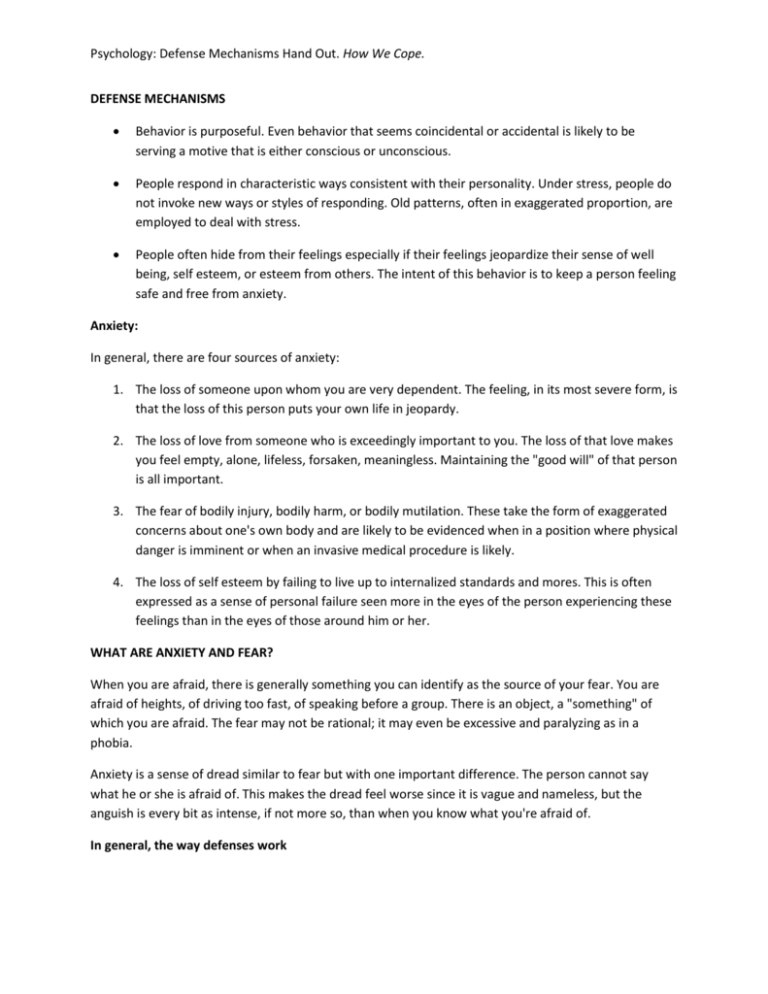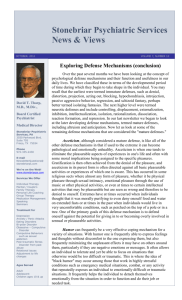1. Defense Mechanisms Nutshell
advertisement

Psychology: Defense Mechanisms Hand Out. How We Cope. DEFENSE MECHANISMS Behavior is purposeful. Even behavior that seems coincidental or accidental is likely to be serving a motive that is either conscious or unconscious. People respond in characteristic ways consistent with their personality. Under stress, people do not invoke new ways or styles of responding. Old patterns, often in exaggerated proportion, are employed to deal with stress. People often hide from their feelings especially if their feelings jeopardize their sense of well being, self esteem, or esteem from others. The intent of this behavior is to keep a person feeling safe and free from anxiety. Anxiety: In general, there are four sources of anxiety: 1. The loss of someone upon whom you are very dependent. The feeling, in its most severe form, is that the loss of this person puts your own life in jeopardy. 2. The loss of love from someone who is exceedingly important to you. The loss of that love makes you feel empty, alone, lifeless, forsaken, meaningless. Maintaining the "good will" of that person is all important. 3. The fear of bodily injury, bodily harm, or bodily mutilation. These take the form of exaggerated concerns about one's own body and are likely to be evidenced when in a position where physical danger is imminent or when an invasive medical procedure is likely. 4. The loss of self esteem by failing to live up to internalized standards and mores. This is often expressed as a sense of personal failure seen more in the eyes of the person experiencing these feelings than in the eyes of those around him or her. WHAT ARE ANXIETY AND FEAR? When you are afraid, there is generally something you can identify as the source of your fear. You are afraid of heights, of driving too fast, of speaking before a group. There is an object, a "something" of which you are afraid. The fear may not be rational; it may even be excessive and paralyzing as in a phobia. Anxiety is a sense of dread similar to fear but with one important difference. The person cannot say what he or she is afraid of. This makes the dread feel worse since it is vague and nameless, but the anguish is every bit as intense, if not more so, than when you know what you're afraid of. In general, the way defenses work Psychology: Defense Mechanisms Hand Out. How We Cope. Defenses are designed to keep a person from consciously experiencing anxiety. If defenses are operating smoothly, a person does not experience the pain of anxiety. This is not the time that a person will seek out help. The presence of anxiety is a sign that defenses are not performing their tasks; they are not working as well as they should. Defenses find their origins in normal coping styles that were once appropriate to a certain developmental period. A young child who uses DENIAL may be coping with the world in the only way he or she knows. An adult who uses DENIAL is invoking a means for managing his or her world that does not take into account that there are more mature means available for dealing with anxiety. Defenses function automatically. A person does not have to think about which defense will be used in order to handle stress and anxiety. In a well operating system, a barely detectable threat of anxiety is sufficient to bring the defensive network into play. Often people have no idea at all that their response is defensive and equally often, do not appreciate being told that they are defensive. Defenses sacrifice reality to a greater or lesser extent. A defense's main purpose is to change experience so that anxiety will not be felt. If that requires reshaping reality in order to achieve that goal, it will be done. In some cases, the reshaping is unnoticeable. In major psychological disturbances, the loss of reality is blatantly apparent. SOME OF THE MAJOR DEFENSES: PROJECTION: This defense involves the disowning of thoughts and feelings that are experienced as painful or uncomfortable. Thus, if being angry or rageful is an unacceptable emotion, the person projects these feelings onto someone else. "I am not the one who is angry. You are angry with me."A frequent form of projection is seen in the person who never takes responsibility for anything. Nothing is ever that person's fault. The exam is failed because the professor asked stupid questions. He is late because the trains are never on time. She was fired because the boss had something against her. DENIAL: In the simplest terms, denial is a way of saying that something that is too painful to deal with is simply not so. It is the kind of disbelief that follows hearing about the sudden death of someone who is near and dear. "I can't believe it" is really a form of "I don't want to believe it." The impression you get of someone who employs denial is of someone who is wearing blinders, refusing to see what is obviously there. SOMATIZATION: This defense involves translating an emotional problem or conflict into a physical symptom. Tension headaches, colitis, ulcers, and spastic colons are symptom pictures that are likely to involve a strong psychological component. Instead of dealing directly with the "problem," it is symbolically expressed in a physical symptom. RATIONALIZATION: To rationalize is to offer sound, acceptable, intellectual, often seemingly irrefutable reasons for why you do what you do. Since most actions are motivated by more than one reason, Psychology: Defense Mechanisms Hand Out. How We Cope. rationalization involves picking the "best" reason to present to the public and even to yourself. It is designed to keep the "real," less acceptable motive out of conscious awareness. ISOLATION OF AFFECT: This defense involves a split between thoughts and feelings. Painful, troublesome, frightening feelings are removed from the thoughts they usually accompany and forced from conscious awareness. This defensive style is recognizable in the person who is able to talk about things that would ordinarily make a person wince without any noticeable feeling. A doctor describing a mutilated accident victim in cool clinical terms is someone who is adaptively using isolation of affect. REACTION FORMATION: This defense involves turning the forbidden wish into its opposite. If the unacceptable wish is to be overwhelmingly dependent, this defense would be expressed in terms of exaggerated independence and autonomy. Another example is the person who feels an uncontrollable need to drink. Under the influence of reaction formation, this person might become a member of a Temperance Society that forbids all drinking, pickets taverns, and does everything possible to stop the entire world from drinking alcoholic beverages. The key to recognizing this defensive behavior is that it is "too much." The person seems to be on some kind of holy cause that is pursued unrelentingly and rigidly. INTELLECTUALIZATION: This defensive style is a cousin to Isolation of Affect. Feelings are not allowed into consciousness. Instead, issues are discussed in a hyper intellectual manner. Everything is examined from every possible point of view. Everything is taken seriously; humor does not seem possible. A person who intellectualizes seems to rob life of its spontaneity and replaces it with an exaggerated sense of seriousness and microscopic scrutiny. AVOIDANCE: This is not a very sophisticated defense although it may involve a great deal of rearranging of one's life. Its intent is to keep the person away from whatever it is that generates anxiety. Thus, if a person is made uncomfortable by crowds, the person simply never gets into a situation where he or she will be in a crowd. REPRESSION: This defense is the cornerstone of all the defenses. Every defense involves some component of repression. To repress something is to lose it from conscious awareness. Repression functions automatically. You just forget. If you've ever forgotten a dentist appointment, you have some understanding about how repression works. Memories and feelings that are charged with painful content become lost behind a barrier that is experienced as impenetrable. SUPPRESSION: Similar to repression in that painful thoughts and feelings are lost to awareness. This tactic involves an act of conscious will. It requires a decision to forget. "I am not going to think about that" comes close to capturing the essence of suppression. DISPLACEMENT: Feelings that belong to one particular person are transferred to another. If the boss makes you angry but expressing that anger might cost you your job, you might express that anger at a subordinate or at your wife or husband. This is a version of "coming home and kicking the cat" for all the bad things that happened during the day. It is important to keep in mind that the person is unaware that Psychology: Defense Mechanisms Hand Out. How We Cope. a displacement has taken place. The person may not even be aware that he is angry at the boss; he is simply aware that he is angry or upset and the most convenient and available target catches the anger. DISSOCIATION: This defense is among the more serious one. Large portions of experience are lost. Amnesia is a good example. A person can't remember having done something. The closest experience to a 'dissociative episode' is when we drive somewhere, get there, and can't remember having been involved in the process of driving the car at all. It was as if we were on automatic pilot; our minds were otherwise engaged. Another way dissociation is described is when we feel as if we are watching ourselves from outside our bodies. It is as if we have divided in two; one part doing and the other part watching. THE NATURE OF COPING STYLES: Style implies a pattern of predictable behaviors, a way of handling situations that remains consistent over time. For example, people are described as having conservative styles, or risk-taking styles, thoughtful styles, or impulsive styles. Ideally, the way a person solves problems should be related to the problem at hand. Different problems call for different problem solving techniques. The more techniques available, the more effective a person can be as he or she approaches the demands life imposes.




